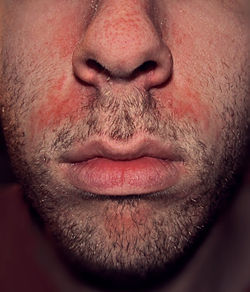Seborrheic dermatitis
| Seborrheic dermatitis | |
|---|---|
| Synonyms | seborrhea, sebopsoriasis, seborrheic eczema, pityriasis capitis |
 |
|
| An example of seborrhoeic dermatitis between the nose and mouth | |
| Classification and external resources | |
| Specialty | Dermatology |
| ICD-10 | L21 |
| ICD-9-CM | 690.1 |
| DiseasesDB | 11911 |
| MedlinePlus | 000963 |
| eMedicine | derm/396 |
| MeSH | D012628 |
Seborrheic dermatitis, also known as seborrheic eczema or simply as seborrhea, is a chronic, relapsing and usually mild dermatitis. In infants seborrheic dermatitis is called cradle cap. Dandruff is a type of seborrhoeic dermatitis where inflammation is not present. Seborrheic dermatitis is a skin disorder affecting the scalp, face, and torso. Typically, seborrheic dermatitis presents with scaly, flaky, itchy, and red skin. It particularly affects the sebaceous-gland-rich areas of skin. In adolescents and adults, seborrhoeic dermatitis usually presents as scalp scaling or as redness of the nasolabial fold.
The topical antifungal medications and ciclopirox are both effective for the condition. It is unclear if other antifungals are equally effective as this has not been studied.
Seborrhoeic dermatitis' symptoms appear gradually and usually the first signs are flaky skin and scalp. Symptoms occur most commonly anywhere on the skin of the face, behind the ears and in areas where the skin folds. Flakes may be yellow, white or grayish. Redness and flaking may also occur on the skin near the eyelashes, on the forehead, around the sides of the nose, and the chest and upper back.
In more severe cases, yellowish to reddish scaly pimples appear along the hairline, behind the ears, in the ear canal, on the eyebrows, on the bridge of the nose, around the nose, on the chest, and on the upper back.
Commonly, patients experience mild redness, scaly skin lesions and in some cases hair loss. Other symptoms include patchy scaling or thick crusts on the scalp, red, greasy skin covered with flaky white or yellow scales, itching, soreness and yellow or white scales that may attach to the hair shaft.
Seborrheic dermatitis can occur in infants younger than three months and it causes a thick, oily, yellowish crust around the hairline and on the scalp. Itching is not common among infants. Frequently, a stubborn diaper rash accompanies the scalp rash. Usually, when it occurs in infants the condition resolves itself within days and with no treatment.
...
Wikipedia
